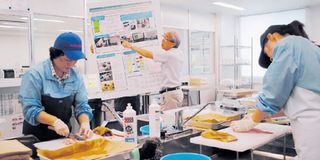Made in Fukushima: Japanese farmers struggle to win trust

Onahama Port employees preparing seafood for radiation tests in Iwaki on July 27, 2018. PHOTO | COURTESY
Koriyama, Japan. The pumpkin is diced, the chicken carved and the eggs beaten into an o
melette, but the people preparing the food are not chefs -- they are scientists testing produce from Japan’s Fukushima region.
Seven years after the March 2011 nuclear disaster caused by a devastating tsunami, rigorous testing shows no radioactive threat from Fukushima’s produce, officials and experts say.
But local producers say they still face crippling suspicion from consumers.
More than 205,000 food items have been tested at the Fukushima Agricultural Technology Centre since March 2011, with Japan setting a standard of no more than 100 becquerels of radioactivity per kilogramme (Bq/kg).
The European Union, by comparison, sets that level at 1,250 Bq/kg and the US at 1,200.
In the last year, the centre says no cultivated produce or farm-reared livestock has exceeded the government’s limit.
In all just nine samples out of tens of thousands were over the limit: eight from fish bred in inland ponds, and one a sample of wild mushrooms.
Each day, more than 150 samples are prepared, coded, weighed, and then passed through a “germanium semiconductor detector”. Rice undergoes screening elsewhere.
While radiation affected several regions which have their own testing processes, Fukushima’s programme is the most systematic, testament to the particularly severe reputational damage it suffered.
In the wake of the nuclear disaster, a wide-scale decontamination programme has been carried out in Fukushima.
It can’t be done in forests, where thick tree growth makes it impractical. But elsewhere topsoil has been removed, trees washed down and potassium sprinkled to reduce caesium uptake.
But the testing process is the cornerstone of efforts to win consumer trust.
‘Our products are safe’
“Some people are still worried, in Japan and abroad, so we want to continue to explain to people in other prefectures and in foreign countries that our products are safe,” said Kenji Kusano, an official at the testing centre.
And occasionally radioactivity is detected, for example in wild plants and mushrooms, which are destroyed if they exceed the government standard.
Kusano said testing will remain important as residents gradually return.
“When residents come back to areas that are off-limits at the moment and start producing their own fruit and vegetables, they must be tested,” he said.
The Fukushima disaster devastated a previously flourishing local agricultural sector.
“Profits have not yet reached pre-2011 levels and prices remain below the national average,” said Fukushima representative Nobuhide Takahashi.
The situation is even worse for fisherman, many of whom have survived only on compensation paid by Fukushima operator TEPCO. The tsunami destroyed ports across the region and demand is low despite an even stricter testing standard of 50Bq/kg for Fukushima’s seafood.
“When we catch fish and send it to market in Tokyo, some people don’t want to buy it,” said Kazunori Yoshida, director of Iwaki’s fishing cooperative.
As a result, fishermen brought in just 3,200 tonnes of seafood in the area last year, down from 24,700 in 2010. (AFP)




